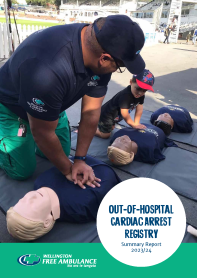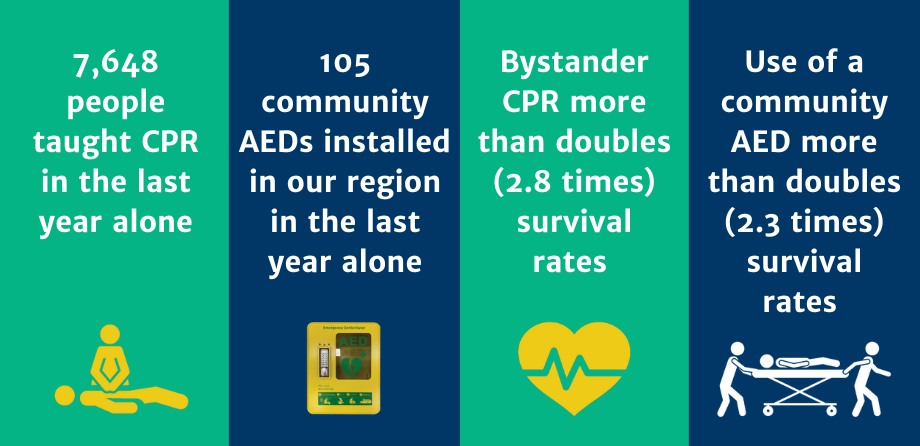About us
Our news
Out-of-Hospital Cardiac Arrest Registry 2023/2024
Out-of-Hospital Cardiac Arrest Registry 2023/2024
 20 February 2025
20 February 2025
Out-of-Hospital Cardiac Arrest Registry 2023/2024
Every year in Aotearoa New Zealand, over 2,000 people are treated for a cardiac arrest that happens in the community. Cardiac arrest is the sudden loss of heart function. Without quick help, cardiac arrest is fatal. For every minute without CPR (cardiopulmonary resuscitation) or defibrillation, a patient’s chance of survival falls by 10–15 percent. In 2023 – 2024, Wellington Free Ambulance treated 242 people for a cardiac arrest that happened outside a hospital.
 Around the world, survival rates following out-of-hospital cardiac arrest (OHCA) range from less than 6% to greater than 50%. Benchmarking survival from OHCA is a key measure of the clinical quality of an emergency ambulance service like Wellington Free Ambulance (WFA) and is essential to improve the chances of surviving a cardiac arrest outside of hospital.
Around the world, survival rates following out-of-hospital cardiac arrest (OHCA) range from less than 6% to greater than 50%. Benchmarking survival from OHCA is a key measure of the clinical quality of an emergency ambulance service like Wellington Free Ambulance (WFA) and is essential to improve the chances of surviving a cardiac arrest outside of hospital.
That’s why we and Hato Hone St John (HHSJ) contribute to the annual Out-of-Hospital Cardiac Arrest Registry.
Why the Out-of-Hospital Cardiac Arrest Registry is important
The 2023/2024 Out-of-Hospital Cardiac Arrest Registry is a national report that presents information on all cardiac arrests that happened outside of hospital and were attended by HHSJ and WFA between 1 July 2023 and 30 June 2024.
The purpose of the report is to identify survival rates of OHCA and benchmark internationally to help identify and address any possible improvements to clinical care.
The report also benchmarks bystander CPR and the use of an AED (automated external defibrillator) before an ambulance arrives, plus patients’ survival to 30 days after their cardiac arrest. Read the national combined service report.
As well as the national report that includes data from both emergency ambulance services in Aotearoa New Zealand, a separate WFA report is available that focuses specifically on OHCA in our region – have a read.
The impact of The Lloyd Morrison Foundation Heartbeat programme
The Lloyd Morrison Foundation Heartbeat programme has a significant impact in our community, training people how to respond in a sudden cardiac arrest (SCA).
- Last year 7,648 people across the WFA region were taught lifesaving CPR skills and how to use an AED - as this report demonstrates, both greatly impact a person’s chances of surviving a SCA.
- Our region has over 500 AEDs installed and maintained by WFA.
Thanks to the ongoing generosity of Julie Nevett and The Lloyd Morrison Foundation all Heartbeat CPR training is freely available, and all community AEDs are maintained free of charge.
Nationally, the research tells us that most people who experienced a cardiac arrest experienced this at home (72%). The research also tells us that bystander CPR more than doubles (2.8 times) survival rates and the use of a community AED prior to the arrival of emergency ambulance services more than doubles (2.3 times) survival rates.
Last year, 137 AEDs were installed across the WFA region, 105 are community AEDs, accessible 24/7 and maintained free of charge thanks to Julie Nevett and The Lloyd Morrison Foundation.

From a Wellington Free Ambulance perspective – benchmarking over the past six years:
- The number of people receiving bystander CPR is the highest in six years at 80%.
- The use of an AED by a community responder is the highest in six years with 10% of people receiving defibrillation before an ambulance arrived.
- The return of spontaneous circulation (or the restart of a sustained heart rhythm) on arrival to hospital remained consistent on the previous year at 26%.
- The number of patients surviving to 30 days after a cardiac arrest also remained consistent on the previous year at 14%.
